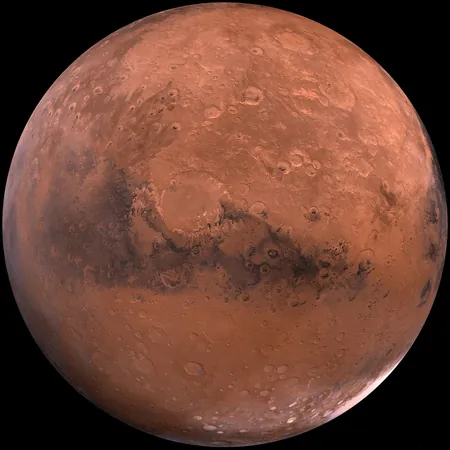
Unraveling Mars' Dust Storms: A New Frontier in Planetary Weather Forecasting!
2024-12-09
Author: Liam
Introduction
In an intriguing new study from planetary scientists at the University of Colorado Boulder, researchers are uncovering the mysterious forces behind Mars' notorious dust storms, which can envelop the entire planet in a chaotic swirl of grit. The groundbreaking findings suggest that unusually warm and sunny days may actually trigger these colossal storms.
Lead author Heshani Pieris, a graduate student at the Laboratory for Atmospheric and Space Physics (LASP), emphasizes the importance of this research in enhancing our understanding of Martian weather. “Dust storms significantly impact rovers and landers on Mars, and they will be critical to monitor during future manned missions,” she explains. The lightweight dust clings to equipment and poses serious challenges for exploration.
Pieris will present these compelling findings on December 10 at the 2024 American Geophysical Union meeting in Washington. The team's approach leverages real-time observations collected by NASA's Mars Reconnaissance Orbiter, a key tool that has enabled them to analyze existing weather patterns and how they contribute to approximately two-thirds of Mars' major dust storms.
Co-author Paul Hayne, an associate professor at LASP, notes, “Understanding the transition from smaller storms to global dust storms is crucial. Our grasp of the fundamental physics behind how these storms commence at the Martian surface remains incomplete.”
The Awe-inspiring Nature of Mars' Dust Storms
Dust storms on Mars present a captivating phenomenon. Typically, they initiate as minor storms swirling around the icy poles and then, as Mars' year progresses (lasting 687 Earth days), these storms can escalate dramatically, stretching toward the equator and covering vast areas for days on end.
While the cinematic portrayal of such storms, as seen in the 2015 film *The Martian*, depicts a dramatic and catastrophic environment, the reality is somewhat different. Mars' atmosphere is significantly thinner than Earth's, which limits the force these storms can generate. However, they are still a serious hazard for equipment and future astronauts. For instance, a global dust storm in 2018 suffocated the solar panels of NASA's Opportunity rover, leading to its demise.
“Even if the wind pressure isn’t enough to topple equipment, the dust grains can arrive with considerable speed, impacting astronauts and gear,” Hayne asserts.
A Closer Look at Martian Weather Patterns
The study hones in on two recurring weather patterns, dubbed “A” and “C” storms, that are prevalent on Mars. By analyzing an extensive range of data from the Mars Climate Sounder, the researchers tracked changes over eight Martian years (equivalent to nearly 15 Earth years), focusing on periods of notable warmth—when sunlight penetrated Mars' thin atmosphere to warm the surface.
Remarkably, they found that around 68% of major storms were preceded by a spike in surface temperatures. This correlation hints at a process whereby the warming of the Martian surface sets the stage for developing dust storms. “It’s as if Mars waits for its atmosphere to clear before unleashing a massive dust storm,” Hayne suggests.
While the researchers cannot definitively state that these warmer conditions directly lead to dust storms, Pieris draws parallels to Earth where similar weather patterns occur. In Boulder, Colorado, for example, the heating of the surface creates buoyant air pockets that can lead to towering clouds and storms.
Their ongoing research intends to integrate more recent observational data from Mars with hopes of predicting weather patterns live, ultimately striving to develop forecasts for upcoming Martian conditions.
“This study is just a pivotal first step towards monitoring storms on Mars,” Pieris reflects, “but we’re hopeful it will push the boundaries of what we can achieve in planetary weather forecasting.”
As humanity prepares for its next leap into the cosmos, understanding the tumultuous weather on Mars could be crucial for the safety and success of future missions to the Red Planet. Keep an eye on the horizon as we advance closer to deciphering Martian meteorology!









 Brasil (PT)
Brasil (PT)
 Canada (EN)
Canada (EN)
 Chile (ES)
Chile (ES)
 España (ES)
España (ES)
 France (FR)
France (FR)
 Hong Kong (EN)
Hong Kong (EN)
 Italia (IT)
Italia (IT)
 日本 (JA)
日本 (JA)
 Magyarország (HU)
Magyarország (HU)
 Norge (NO)
Norge (NO)
 Polska (PL)
Polska (PL)
 Schweiz (DE)
Schweiz (DE)
 Singapore (EN)
Singapore (EN)
 Sverige (SV)
Sverige (SV)
 Suomi (FI)
Suomi (FI)
 Türkiye (TR)
Türkiye (TR)